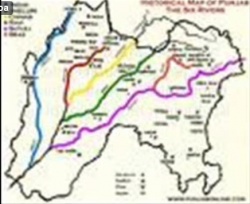Template:AOW288: Difference between revisions
Hari singh (talk | contribs) (Created page with '{{aowh2|Anandpur Sahib Resolution|Anandpur Resolution|passed on 28 August, 1973}} {{P|File:Anandpur Resolution.jpg|Anandpur Sahib Resolution}} '''Anandpur Sahib Resolution''', a…') |
Allenwalla (talk | contribs) mNo edit summary |
||
| Line 4: | Line 4: | ||
'''Anandpur Sahib Resolution''', a frequently invoked document of modern [[Sikhism]] pronouncing its religious rule as well as its political goal. It was a resolution for the "self-determination" of the state of [[Punjab]] and was passed on [[28 August]] 1973 at [[Anandpur Sahib]]. That resolution is now called 'Anandpur Sahib Resolution'. | '''Anandpur Sahib Resolution''', a frequently invoked document of modern [[Sikhism]] pronouncing its religious rule as well as its political goal. It was a resolution for the "self-determination" of the state of [[Punjab]] and was passed on [[28 August]] 1973 at [[Anandpur Sahib]]. That resolution is now called 'Anandpur Sahib Resolution'. | ||
After having enjoyed power under chief ministers, Gurnam Singh and [[Parkash Singh Badal]] in the [[Punjab]] | After having enjoyed power under chief ministers, Gurnam Singh and [[Parkash Singh Badal]] in the [[Punjab]] (newly demarcated in 1966) [[Sikh]]s, represented by their premier political party, the [[Shiromani Akali Dal]], were able to capture only one seat in the elections to the Indian parliament (1971) from among which, 13 were allocated to Punjab. | ||
In the Punjab Assembly elections which took place in March 1972 their tally was a mere 24 seats of a total of 117, and the Punjab Government passed in to the hands of the Congress Party, with [[Giani Zail Singh]] (later, President of India) as chief minister. <!-----This electoral debacle led to self introspection on the part of the Shiromani Akali Dal which appointed on 11 December, 1972, a sub-committee to reflect upon the situation and to proclaim afresh the programme and polices of the Dal. | In the Punjab Assembly elections which took place in March 1972 their tally was a mere 24 seats of a total of 117, and the Punjab Government passed in to the hands of the Congress Party, with [[Giani Zail Singh]] (later, President of India) as chief minister. <!-----This electoral debacle led to self introspection on the part of the Shiromani Akali Dal which appointed on 11 December, 1972, a sub-committee to reflect upon the situation and to proclaim afresh the programme and polices of the Dal. | ||
The 12 member committee consisted of Surjit Singh Barnala, Gurcharan Singh Tohra, Jiwan Singh Umranangal, Gurmeet Singh, Dr. Bhagat Singh, Balwant Singh, Gian Singh Rarewala, Amar Singh Ambalavi, Prem Singh Lalpura, Jaswinder Singh Brar, Bhag Singh, and Major General Gurbakhsh Singh of Badhani.------> {{aowf|Anandpur Sahib Resolution}} | The 12 member committee consisted of Surjit Singh Barnala, Gurcharan Singh Tohra, Jiwan Singh Umranangal, Gurmeet Singh, Dr. Bhagat Singh, Balwant Singh, Gian Singh Rarewala, Amar Singh Ambalavi, Prem Singh Lalpura, Jaswinder Singh Brar, Bhag Singh, and Major General Gurbakhsh Singh of Badhani.------> {{aowf|Anandpur Sahib Resolution}} | ||
Revision as of 18:38, 23 August 2009
Anandpur Sahib Resolution, a frequently invoked document of modern Sikhism pronouncing its religious rule as well as its political goal. It was a resolution for the "self-determination" of the state of Punjab and was passed on 28 August 1973 at Anandpur Sahib. That resolution is now called 'Anandpur Sahib Resolution'.
After having enjoyed power under chief ministers, Gurnam Singh and Parkash Singh Badal in the Punjab (newly demarcated in 1966) Sikhs, represented by their premier political party, the Shiromani Akali Dal, were able to capture only one seat in the elections to the Indian parliament (1971) from among which, 13 were allocated to Punjab.
In the Punjab Assembly elections which took place in March 1972 their tally was a mere 24 seats of a total of 117, and the Punjab Government passed in to the hands of the Congress Party, with Giani Zail Singh (later, President of India) as chief minister. .....More

